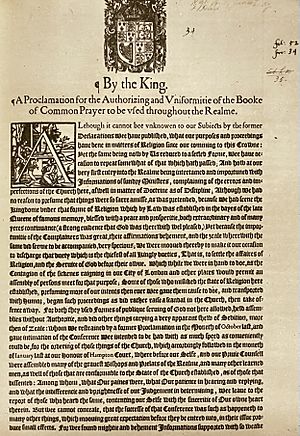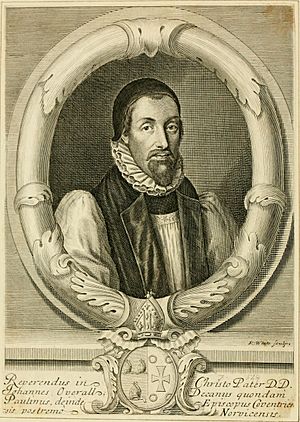Book of Common Prayer (1604) facts for kids
The 1604 Book of Common Prayer was a special prayer book used by the Church of England. People also called it the Jacobean prayer book or the Hampton Court Book. It was the fourth version of the Book of Common Prayer. This book came out when King James I started ruling England. It was created after a big meeting called the Hampton Court Conference. At this meeting, different groups like Anglicans, Puritans, and Presbyterians talked about church rules. The 1604 book was a small update to the 1559 prayer book. It later became the main guide for the 1662 Book of Common Prayer. That 1662 book is still used today in the Church of England and by Anglican churches worldwide.
Contents
Why a New Prayer Book?
The Book of Common Prayer became the main guide for church services in the Church of England after the English Reformation. It replaced many old Catholic books. The new books used English and followed reformed ideas. The 1549 and 1552 prayer books were mostly written by Thomas Cranmer. He was the Archbishop of Canterbury.
After Queen Mary I died, Elizabeth I became queen. Mary had brought back Catholic ways for a short time. Elizabeth brought back the reformed services using the 1552 prayer book as a guide. Queen Elizabeth faced challenges from different groups. These included Protestants who wanted more changes and Catholics who refused to follow the new church. There were also debates like the Vestment Controversy about what priests should wear. These issues led to the Elizabethan Religious Settlement. The Church of England tried to find a middle way between Protestant and Catholic ideas.
When James VI was King of Scotland, Scottish churches used the Book of Common Order. This book followed the ideas of John Knox. King James VI was given an English prayer book. Copies were sold in Edinburgh. However, James did not like the idea of a "mass said in English." Some Puritans even wanted to remove the Scottish Book of Common Order. In his book Basilikon Doron, James showed he supported a middle way for the church.
The Hampton Court Meeting
When James VI became King of England in 1603 (as James I), English Puritans saw a chance. They hoped the new king would bring his Scottish church practices with him. Some Puritans gave him the Millenary Petition as he traveled to London. In response, King James called a meeting at Hampton Court. This meeting is known as the Hampton Court Conference.
At the conference, King James shared his thoughts on different church practices. He did not like "lay baptisms." These were baptisms done by people who were not church ministers. This practice was common after the English Reformation. Sometimes, midwives would baptize babies if they thought the child might die before a minister could arrive. King James said that a monkey could baptize as well as a woman. So, the new 1604 prayer book changed the rules for private baptisms. It said only a parish minister or "other lawful Minister" could perform them. This stopped all lay baptisms, including those done by women.
King James announced that he wanted "one Doctrine and one discipline, one Religion in substance, and in ceremony." He warned that those who did not accept the new prayer book would face problems. The new prayer book was the 1559 prayer book with small changes agreed upon at the conference. King James wanted everyone to follow the new rules for services and clothing for ministers. Many ministers had to promise to follow these rules. About 80 ministers lost their jobs because they did not accept the new prayer book.
The new prayer book also had a longer catechism. This meant no other teaching documents were needed. New church laws were also reviewed. These laws were put in place in March 1604. They brought together older rules from Queen Elizabeth's time. These new laws were used with the newly approved prayer book.
How People Reacted
The Puritans did not like the 1604 prayer book. They did not agree with baptismal regeneration (the idea that baptism washes away sins). They also did not like kneeling to receive Communion. These people wrote pamphlets to show their disapproval. In 1605, ministers in the Diocese of Lincoln wrote a petition. It used quotes from Reformed thinkers to argue against the new prayer book. In 1606, a book called Survey of the Book of Common Prayer pointed out problems in different versions of the prayer book. It suggested using Scotland's Book of Common Order to unite England and Scotland.
In Scotland, some people accepted the prayer book. They saw it as a way to unite with England under one king. Scottish ordinations (making someone a minister) followed the prayer book. From 1617, it was used daily in the Chapel Royal at Stirling Castle.
William Laud and his followers became more powerful in the 1620s and 1630s. Laud tried to bring in his own revised prayer book in 1637. This made many people in Scotland even more against Anglican church services. In 1638, the Church of Scotland synod (church council) got rid of both bishops and the prayer book. Laud's policies in England also made Puritans angry. The Long Parliament criticized Laud's practices in 1640 and 1641.
On March 13, 1645, the Puritan Parliament passed a law. It made using the prayer book a crime. The 1604 prayer book was printed only once more in English that year. It was also printed in Dutch for the first time. The 1604 prayer book was not printed again until 1659. During this time, Parliament replaced the prayer book with the Directory of Public Worship.
Changes from Earlier Books
The 1604 prayer book was only a small update compared to other versions of the Book of Common Prayer. There were minor changes to the services and prayers. A "Prayer for the Royal Family" was added to the end of the litany. This made the Divine Service even longer. Six prayers of thanksgiving were also added. Lessons from the Apocrypha were removed.
The title of the Absolution (a prayer asking for forgiveness) had "or Remission of sins" added to it. Similarly, "Or laying on of hands" was added to the title of Confirmation. As agreed at Hampton Court, the rule that baptisms must be done by lawful ministers was included. The new final part of the catechism was written by John Overall. He was then the Dean of St Paul's.
Lasting Impact
The 1604 prayer book is usually seen as a "minor" update to the 1559 prayer book. It was mainly created because of the Puritans. The religious disagreements that led to the 1604 prayer book have been seen in plays by William Shakespeare. Macbeth is one example.
The 1604 prayer book was the first Book of Common Prayer translated into other languages. It was translated into Manx in 1610, Spanish in 1623, and Ancient Greek in 1638. A French version was printed in London in 1616 for use in the Channel Islands. The first time the 1604 prayer book was printed after the Puritan ban in 1645 was in Hamon L'Estrange's 1659 book, The alliance of divine offices.
When the Stuart Restoration happened, the prayer book was brought back. The new government wanted to simply reprint the 1604 prayer book. However, both Laudians and Presbyterians pushed for changes. A 1619 printing of the Jacobean prayer book had notes and changes added by John Cosin. This became known as the Durham Book. William Sancroft added these changes to a 1634 copy of the 1604 prayer book. This copy is known as the Fair Copy.
The Convocation (church assembly) was encouraged to adopt a revised prayer book after the 1661 Savoy Conference. They accepted these changes with a modified 1636 copy, called the Convocation Book. The version that became the 1662 Book of Common Prayer removed the "Black Rubric." This rule had stopped people from kneeling when receiving the Eucharist. This change led to discussions about what Anglicans believed about consubstantiation and transubstantiation.
See also
- Book of Common Prayer (1979)
- Customary (liturgy)
- James VI and I and religious issues
- Pontifical




